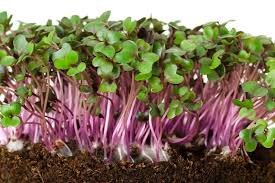Are you interested in growing your own nutritious greens right at home? If so, cabbage microgreens might just be the perfect choice for you! These tiny plants are packed with flavor and nutrients, Growing Cabbage Microgreens A Quick and Easy Guide makes them a fantastic addition to salads, sandwiches, and garnishes. In this guide, we’ll explore everything you need to know about growing cabbage microgreens, from the basics to the best practices, ensuring you’ll be successful in your endeavor.
What Are Cabbage Microgreens?
Cabbage microgreens are the young seedlings of cabbage plants, harvested just after the first true leaves appear. They are not only delicious but also incredibly nutritious, offering a wealth of vitamins and antioxidants. Depending on the variety of cabbage you choose—such as green, red, or savoy—you’ll find a range of flavors, from mild and sweet to spicy and peppery.
One of the best things about cabbage microgreens is how quickly they grow. You can typically harvest them in about 7 to 14 days, Growing Cabbage Microgreens A Quick and Easy Guide makes them an excellent option for those who want to see quick results from their gardening efforts.
Why Choose Cabbage Microgreens?
You might be wondering why cabbage microgreens are such a popular choice among home gardeners. Here are a few compelling reasons:
- Nutritional Benefits: Cabbage microgreens are loaded with vitamins A, C, E, and K, along with essential minerals like calcium and iron. They’re a great way to boost your daily nutrient intake without a lot of effort.
- Flavor Variety: With various cabbage types available, you can enjoy different tastes. For instance, red cabbage microgreens tend to be slightly spicier than their green counterparts, offering a unique flavor profile for your dishes.
- Easy to Grow: These microgreens are perfect for beginners. They’re forgiving and don’t require a lot of special care, making them an excellent starting point for anyone looking to explore gardening.
- Versatile in the Kitchen: You can use cabbage microgreens in a variety of dishes. Toss them into salads, blend them into smoothies, or use them as a garnish for soups and entrees. Their versatility means they can enhance a wide range of meals.
How to Grow Cabbage Microgreens
Now that you know what cabbage microgreens are and why they’re a great choice, Growing Cabbage Microgreens A Quick and Easy Guide let’s dive into the steps for growing them. It’s easier than you might think!
Gather Your Supplies: Start by collecting the necessary materials:
-
- Cabbage microgreen seeds: You can find these at local garden centers or online.
- A shallow tray or container: Look for one with drainage holes to prevent waterlogging.
- Seed-starting soil or a growing medium: This will provide the nutrients your seeds need to thrive.
- Water: A spray bottle or a watering can will work well for keeping the soil moist.
Prepare the Tray: Fill your chosen tray with the seed-starting soil, leaving about an inch of space at the top. Use your fingers to gently press the soil down to create an even surface.
Sow the Seeds: Sprinkle the cabbage seeds evenly over the soil surface. Aim for a dense planting, but make sure not to overcrowd the seeds. After sowing, lightly cover the seeds with a thin layer of soil to protect them.
Watering: Mist the soil lightly using a spray bottle to ensure the seeds are adequately moistened without washing them away. It’s important to keep the soil moist but not soggy.
Create the Right Environment: Cabbage microgreens thrive in warm conditions. Place your tray in a warm, well-lit area, preferably with temperatures between 65°F to 75°F (18°C to 24°C). If you lack natural light, consider using grow lights to provide sufficient illumination.
Keep Them Moist: During the germination phase, mist the seeds daily to maintain moisture. You can cover the tray with a lid or plastic wrap for the first few days to help retain humidity, but make sure to remove it once the seeds start to sprout.
Harvesting: After about 7 to 14 days, your microgreens will be ready to harvest. Use a pair of scissors to cut them just above the soil line. Fresh microgreens taste best when enjoyed immediately, but you can store them in the fridge for up to a week.
Tips for Successful Growth
To ensure your cabbage microgreens thrive, Growing Cabbage Microgreens A Quick and Easy Guide here are some additional tips:
- Avoid Overwatering: Too much moisture can lead to mold or a condition called dampening off, which can kill your seedlings. It’s essential to strike a balance—keeping the soil moist without making it soggy.
- Rotate the Tray: If you’re growing under natural light, rotate the tray occasionally to ensure even growth. This helps prevent your microgreens from leaning toward the light source.
- Experiment with Varieties: Don’t be afraid to try different cabbage varieties to discover your favorites. Each type can offer a unique taste and aesthetic for your dishes.
Nutritional Benefits of Cabbage Microgreens
One of the standout features of cabbage microgreens is their nutritional profile. Just a small serving can provide a significant boost to your daily intake of vitamins and minerals. Here are some specific benefits:
- High in Antioxidants: Cabbage microgreens contain antioxidants that help combat oxidative stress in the body, supporting overall health.
- Supports Digestion: The fiber content in these greens can aid in digestion, helping to keep your gut healthy.
- Boosts Immune Function: The vitamins and minerals found in cabbage microgreens can help strengthen your immune system, keeping you healthy year-round.
Storing Your Cabbage Microgreens
If you have a bountiful harvest, you might want to store some of your cabbage microgreens for later use. Here’s how to do it effectively:
- Keep Them Cool: Store your harvested microgreens in a clean container in the refrigerator. A sealed plastic bag or an airtight container works well.
- Use Paper Towels: Place a paper towel in the container with your microgreens to absorb excess moisture, helping to keep them fresh longer.
- Consume Quickly: For the best flavor and nutritional benefits, try to consume your microgreens within a week.
Common Mistakes to Avoid
While growing cabbage microgreens is straightforward, there are a few common pitfalls to watch out for:
- Not Enough Light: Ensure your microgreens receive adequate light. Lack of light can lead to leggy plants that are weak and less flavorful.
- Ignoring Airflow: Good airflow is crucial for healthy microgreens. Avoid overcrowding them and consider placing a small fan nearby to improve circulation.
- Neglecting Cleaning: Keep your growing area clean to prevent mold and pests. Regularly wash your trays and tools to ensure a healthy growing environment.
Conclusion
Growing cabbage microgreens is not just a rewarding experience; it’s also a delicious and nutritious way to elevate your meals. With minimal effort and time, you can enjoy a fresh supply of these tiny greens right in your kitchen. Whether you choose to sprinkle them on salads, blend them into smoothies, or use them as a garnish, cabbage microgreens are sure to enhance the flavors of your dishes.
So, are you ready to start your microgreen journey? Grab your seeds, prepare your growing space, and enjoy the many benefits that come with growing your own cabbage microgreens!
FAQS
How much light do cabbage microgreens need?
Cabbage microgreens thrive in bright light. They need about 12-16 hours of light each day. If you don’t have enough natural light, consider using grow lights.
Do I need to soak the seeds before planting?
Soaking cabbage microgreen seeds is optional. Some growers prefer to soak them for a few hours to speed up germination, while others sow them dry.
Can I grow cabbage microgreens indoors?
Absolutely! Cabbage microgreens are perfect for indoor gardening. Just make sure they have enough light and warmth.
What is the best temperature for growing cabbage microgreens?
They prefer temperatures between 65°F to 75°F (18°C to 24°C) for optimal growth.
How often should I water my cabbage microgreens?
Water them daily, but be careful not to overwater. Use a spray bottle to mist the soil and keep it moist but not soggy.
Can I reuse the soil for my microgreens?
It’s best to use fresh soil for each new batch of microgreens to avoid pathogens and ensure healthy growth.
How do I know when to harvest my cabbage microgreens?
Harvest when they reach about 2-3 inches in height and have developed their first true leaves. They should be vibrant and lush for the best flavor.



